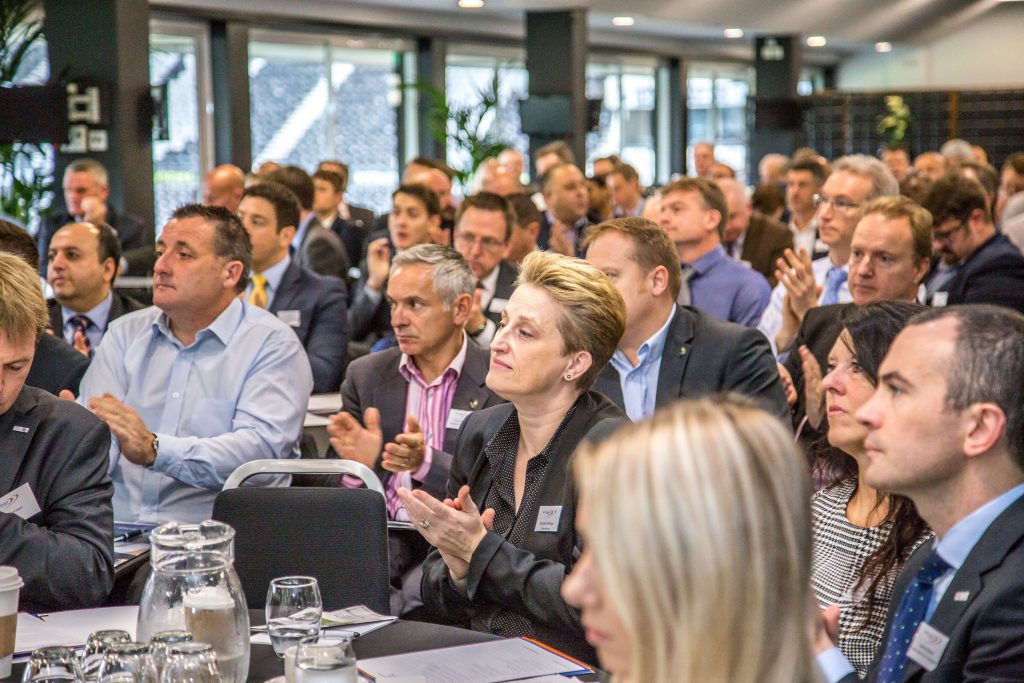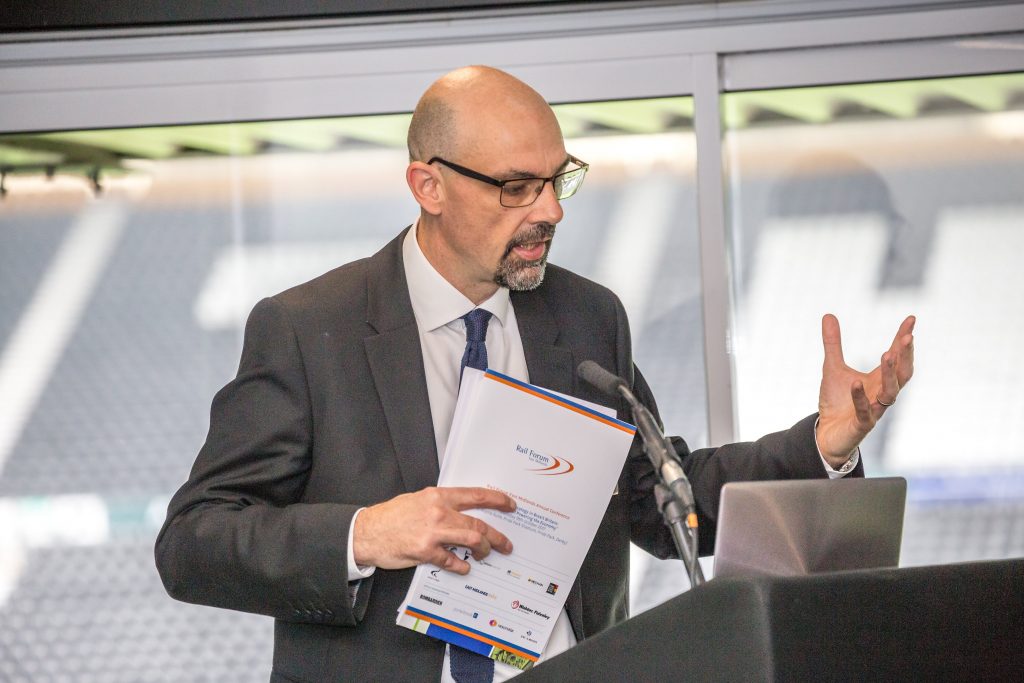Stewart Thorpe attended the Rail Forum East Midlands (RFEM) annual conference to get a flavour of the region’s big plans
It might be overshadowed by its West Midlands neighbour, which continues to press for great devolution and has positioned itself at the centre of Britain’s high-speed rail route maps, but quietly the East Midlands is making significant strides forward for its 2033 showcase.
Looking for a new job in the UK rail industry? Click here to begin your journey

‘Rail Devolution Lite’
In June this year, a new regional transport board met for the first time. Hoping to replicate the success of Transport for the North and Transport for West Midlands, senior leaders of the East Midlands’ local transport authorities came together for the soft launch of Transport for the East Midlands (TfEM).
On the agenda for the inaugural meeting was the transport strategy for the East Midlands’ HS2 station at Toton; the three-year plan for Midlands Connect, which is the transport arm of Midlands Engine; and the East Midlands rail franchise competition.
Leicester’s major, Sir Peter Soulsby, is the group’s chairman and Lincolnshire county council’s transport portfolio holder, Richard Davies, is his deputy. TfEM members meet on a quarterly basis with the Department for Transport (DfT) and Network Rail.
It doesn’t possess the same powers as its sister organisations but the formation of the board is a statement of intent from the local transport authorities that they are working more collectively and collaboratively. Currently the transport board is working in partnership with the DfT on an informal basis to support the next East Midlands rail franchise, an important pre-HS2 award to secure the building blocks for Phase 2’s 2033 opening.
Such is the importance that one representative – David Young of consultancy firm SCP Transport – was seconded to London to work with DfT to inform the franchise’s invitation to tender documents and support the consultation process, which closed in October. The franchise’s current timetable stands as follows:
- April 2018 – invitation to tender process launches;
- Spring 2019 – contract award;
- August 2019 – the next East Midlands franchise begins.

TfEM secretariat Andrew Pritchard described the board’s relationship with DfT as “rail devolution lite” and said that the region now has more purchase than it did previously.
As part of its work with the DfT on the next franchise, Andrew said that TfEM wants to get away from rebranding after each new award in order to build trust between passenger and operator. The recently launched West Midlands Rail was one example TfEM hopes to replicate.
Andrew added that over time the public will see the TfEM brand become more prominent as it establishes a long-term role in the management of the franchise to ensure it remains locally responsive.
“Not everything can be managed out of London and it’s important there is some local accountability,” said Andrew, speaking at RFEM.
“We’re not looking to replicate the direct management and responsibilities that have been taken on by Rail North or West Midlands Rail, but we are looking for a seat around the table and to influence and shape things and help the department and the train operating companies make the most of what they’ve got in the East Midlands.”

Connecting Toton
Outside of London, the East Midlands HS2 interchange at Toton will be the best connected station on the network, with seven trains per hour passing in each direction – four from London and three from Birmingham.
It will directly serve the current population of around 8,238 in the ward of Toton and Chilwell Meadows, Nottinghamshire, but will be expected to serve a far greater catchment area and connect the East Midlands’ major cities.
Toton is situated between the cities of Nottingham and Derby. There are direct bus services to both cities but only by finding the perfect solution to improve the speed and capacity of this connectivity, as well as Leicester and East Midlands Airport, will the wider economic potential of HS2 in the East Midlands be unlocked.
The obvious solution is to extend the existing Nottingham Express Transit (NET) tram line from its current terminus at Toton Lane for one mile to the East Midlands HS2 station, as has been proposed by the East Midlands HS2 Strategic Board (EMHSB). This would involve the least amount of work and would link the station to Boots’ Beeston headquarters, the Queen’s Medical Centre and Nottingham’s city centre. Nevertheless, the tram’s journey time from Toton to Nottingham’s city centre is already more than 30 minutes, which would add a significant time to the proposed 51 minutes high-speed journey from the East Midlands station to London, if it is also a stopping service.

Towards Derby and East Midlands Airport, EMHSB has considered a bus rapid transit, further NET extensions and – should it become a viable technology – a tram-train solution but it said that further work is required to determine the best routes and modes.
Another option put forward by EMHSB is the introduction of classical conventional “shuttle services” from the station to Nottingham and Derby. There would be four of these services per hour, per direction, including stopping and non-stop services.
Local bus company Trent Barton has also contributed to the debate, putting forward suggestions for a future bus route from Toton to Derby using a mix of guided and unguided segregated bus ways, lanes and smart priority signalling. Inspired by designs in Cambridge, these guided busways could run on concrete rather than steel rails.
Nevertheless, with Royal Assent yet to be given, plans for HS2 Phase 2, never mind the rails, are not yet concrete, but it is crucial that the high-speed line is talked about as part of a wider transport strategy if it is to reap the wider economic benefits.

Overdue investment
Sir John Peace delivered the perfect case for better east-west transport connectivity in the Midlands by his late arrival for RFEM’s annual conference.
Sir John, the Lord-Lieutenant of Nottinghamshire and the chair of the Midlands Engine, took more than two hours to travel from Newark to Pride Park, a journey of around 40 miles. Explaining the thinking behind his choice of travel, Sir John said he thought that taking a cab to Newark station, to get on a train and a cab to reach his final destination would have taken him even longer. Yet, if Sir John had taken the train to London, St Pancras International station for example, the more than 120-mile journey would have taken him an hour and a half.
“In terms of investment into the Midlands, the reality is, for the past several decades, we have underinvested,” said Sir John, referring particularly to the East Midlands. “Let’s not kid ourselves, the reason we have these problems on our roads and railways is not because we didn’t have the vision, it’s because we underinvested and underestimated the growth of population, the complexity of society and the economy that has been created. The first thing we have to do is play catchup but, more importantly, we need to get out ahead.”
Summarising Midlands Engine’s Vision for Growth, Sir John said that connectivity is key to drive economic growth in the region – which has under performed compared to other regions – and to close the gap between the gross value added (GVA) of the Midlands and the UK average by 2030. Leaving such issues as Brexit and the scrapped electrification schemes in the past, this will be achieved by contributing to the industries of the “new industrial revolution”, such as artificial intelligence, autonomous vehicles and HS2.

In Sir John’s absence, Maria Machancoses opened the conference by discussing Midlands Connect’s vision for the region.
Maria, the organisation’s director, said it is also working with DfT to help inform transport policy to make sure the region makes the most of HS2. Crucially, she said, improvements aren’t just for the benefit of the region but the country because the regional’s central transport infrastructure is important for the UK.
One scheme Midlands Connect is keen to implement by 2024, to improve east-west connectivity, is improvement work in Birmingham. New Street station has provided no added capacity, said Maria, and signalling and platform work needs to be conducted at Snow Hill and Moor Street stations. This would allow for up to 10 extra trains per hour in and out of Birmingham, linking with the likes of Leicester and Nottingham.
In the Autumn Budget, Midlands Connect was given £5 million to develop plans for rail upgrades in the Midlands.
Returning to EMHSB, Andrew Pritchard said one of its key asks, and another way that east-west connectivity can be transformed, is by opening – at least partially – the East Midlands’ HS2 station in 2030 rather than 2033, which won’t necessarily add further cost to the project, he added.
If that demand is satisfied, the East Midlands’ big ambitions and the wider economic benefits will come to fruition sooner than anticipated, as will its chance to step into the limelight.
Read more: ‘I built Ordsall Chord’

